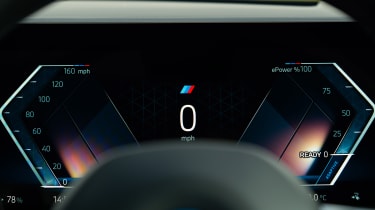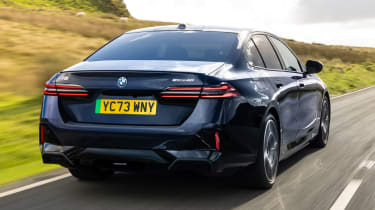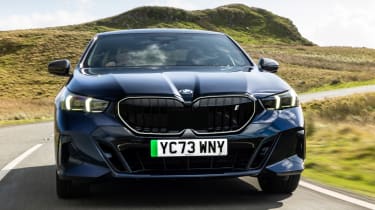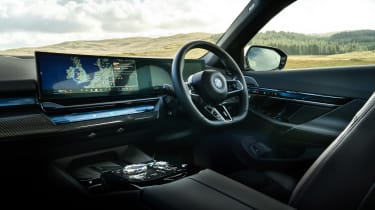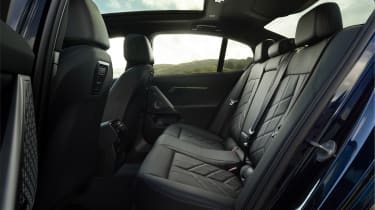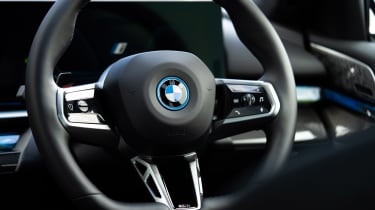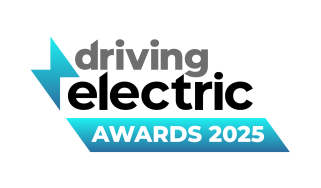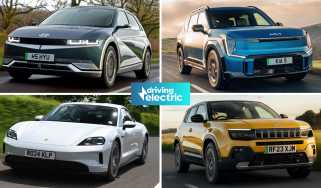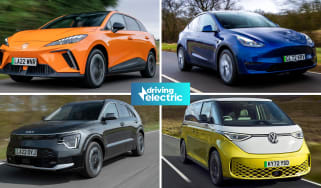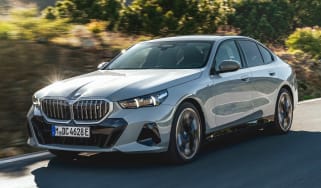BMW i5 review: electric exec, but at what cost?
Plush, poised and packed full of the latest tech, BMW has once again set the bar high in the electric executive market with the first electric 5 Series
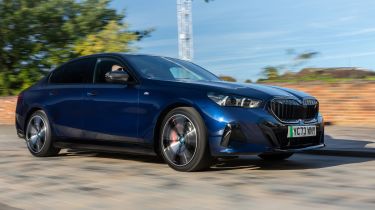
Pros
- Good to drive
- Premium-feeling interior
- Superb infotainment
Cons
- Rivals offer more range
- Feels a tad unwieldy around town
- Very expensive
BMW i5 verdict
If you thought that the switch to electric would blunt BMW’s ability to produce plush-feeling cars that handle superbly, then you’re in for a disappointment. If anything, the BMW i5 shows how great the best electric cars can be, with its dynamic driving experience and exquisite interior. Our pick of the range, the entry-level i5 eDrive40, provides more than enough poke for most drivers, and its roughly 360-mile range is competitive with rivals. If you’re able to swallow the i5’s eye-watering base price, you can’t go wrong with what we think is the most well-rounded luxury electric saloon you can buy.
Details, specs and alternatives
There’s a lot of choice if you’re looking for a BMW electric car; there’s electric SUVs like the iX and iX1, luxury saloons like the i7 and sporty fastbacks such as the i4. Somewhere in the middle of the line-up sits the firm’s latest model, the BMW i5 – an all-electric version of the long-running 5 Series executive car and rival to the Mercedes EQE and Audi A6 e-tron, and also the more exclusive Genesis Electrified G80.
Available in both petrol and electric form, this latest iteration of the 5 Series sits on a modified version of the larger i7’s underpinnings and, from launch, will be available with a choice of two powertrains. No matter whether you choose the entry-level i5 eDrive40 with its 335bhp rear-mounted electric motor, or the range-topping dual-motor i5 M60 xDrive M Performance (a bit of a mouthful, we know), all models come equipped with an 81.2kWh battery pack.
Go easy on the throttle and BMW says the base eDrive40 is capable of up to 357 miles on a charge, with the more powerful M60 suffering a slightly reduced range of 315 miles as a trade-off for the extra power on offer. Of course, these figures can vary depending on which of the various alloy wheel options you pick, while standard 205kW DC rapid charging is competitive in this segment, if not class-leading.
BMW offers the i5 in two high-spec trims in the UK – Sport Edition and M Sport trim, and it’s the latter which we Brits tend to go for, thanks to its racier bodykit and snazzier wheels. All cars get full-LED headlights, a large curved display for the dials and infotainment system, sat-nav, sports seats, a wireless smartphone charger and a host of driver-assistance systems including cruise control and a reversing camera. M Sport adds glitzier body trim, 'Veganza’ vegan leather trim, and stiffer suspension. The M Sport Pro specification adds gloss-black exterior trim and larger wheels, but isn’t really worth the upgrade.
The BMW i5 M60 xDrive M Performance can almost be considered its own standalone model and gets a model-specific version of the maker’s iconic kidney grille, as well as standard 20-inch alloys, adaptive suspension and quad-zone air conditioning.
Both i5 models feature BMW’s latest iDrive infotainment system, which comprises a 12.3-inch digital instrument cluster alongside a huge 14.9-inch touchscreen. This comes with sat-nav, online services, Apple CarPlay and Android Auto built-in, and is partnered with the futuristic-looking ‘BMW Interaction Bar’ – more on that later – as well as a pretty substantial Harman Kardon stereo.
Range, battery size & charging
| Model | Range | Wallbox charge time | Rapid charge |
| eDrive40 | 312-357 miles | 13hrs est (0-100%, 7.4kW) | 30mins (10-80%, 205kW) |
| M60 xDrive | 284-315 miles | 13hrs est (0-100%, 7.4kW) | 30mins (10-80%, 205kW) |
The electric saloon-car market is constantly making headlines, with new models offering range figures now in excess of 400 miles. While the i5 can’t quite keep up with the smaller BMW i4, or the larger BMW i7 in this regard, its legs are still long enough to make it an ideal cross-country motorway cruiser.
During our time driving the i5 in the UK, we were comfortably able to achieve a range of more than 300 miles through a mix of town, country and motorway driving. If you’re intent on making it to your destination without the need to charge, the i5 does have a Max Range function that, in a pinch, severely limits the car’s power and air conditioning to add roughly an extra 15 miles of range.
From March 2025, BMW will introduce a host of tweaks to the i5’s battery tech, liberating more range. You can expect around 29 miles more driving range across the model line-up, depending on trim and options.
Find one of the growing number of 350kW DC ultra-rapid public chargers and BMW says a 10-80% top-up of the i5’s battery will take around half-an-hour. Set a chargepoint as a destination in the satnav and the i5 will precondition its battery for faster charging; of course, topping up at home via a 7.4kW wallbox will take significantly longer.
Running costs & insurance
Costing around £20,000 more than the equivalent petrol 5 Series, the BMW i5 is pretty expensive – it’s around £8,000 pricier trim for trim than the Audi A6 e-tron; it is competitively priced against the likes of the Mercedes EQE, though. That being said, the Beemer’s target demographic – electric company car drivers – will be well served by its low 2% Benefit-in-Kind rating, which means those lucky enough to drive the i5 for business could pay as little as £296 per year in tax.
Electricity is much cheaper than petrol, however, given the i5’s pretty substantial battery pack, charging it won’t be quite as inexpensive as you might think. Doing so at home at the current average electricity rate of 30p/kWh means a full charge will set you back over £20, while using a public rapid charger could cost as much as £55.
It’s also worth preparing yourself for eye-watering insurance premiums as the BMW i5 spans groups 43 to 49, depending on which model you choose. Choosing the electric 5 Series should at least still be cheaper to cover than a Mercedes EQE, though, which will cost you an arm and a leg given all models occupy the highest group, 50.
Performance, motor & drive
| Model | 0-62mph | Top speed | Driven wheels | Power |
| eDrive40 | 6s | 119mph | Rear | 335bhp |
| M60 xDrive | 3.8s | 142mph | Four | 592bhp |
BMWs have long been the choice for executives looking for a sportier driving experience than what’s offered by the equivalent Audi or Mercedes-Benz. This remains the same for the i5 as it feels much more dynamic and composed than its EQE competitor, with light-yet-accurate steering – however it’s not quite as sporty as previous petrol iterations of the 5 Series, nor is it as quiet as the Audi A6 e-tron.
A low centre of gravity means that, despite the i5’s two-tonne-plus kerb weight, body control is tight on a twisty road. However, this excessive bulk does mean the car does tend to bounce about over rough services and stray off-line whenever you throw it into a tight corner – less so than rivals, mind.
As is often the case with German luxury cars, the BMW i5 is offered with several (paid) optional extras that can improve the driving experience somewhat; adaptive dampers lower the ride height by 8mm and allow you to stiffen or slacken-off the suspension for when you’re either looking to attack or waft along a road. Optional rear-wheel-steering also helps the admittedly titanic i5 feel more manoeuvrable at low speeds, as well as more agile and stable when on the move.
The range-topping BMW i5 M60 xDrive is ludicrously fast, catapulting itself from 0-62mph in just 3.8 seconds. We think the more pedestrian eDrive40 should be rapid enough for most buyers, though, with it offering smooth, yet substantial progress whenever you floor the accelerator.
Interior, dashboard & infotainment
BMW has long been conservative when it comes to interior design, favouring incremental upgrades rather than generational leaps. The i5 bucks this trend and feels a lot like the latter, with posh-feeling materials to match the i5’s lofty asking price, plus the touch-sensitive ‘Interaction Bar’ bringing much of the instant wow-factor you’d hope for in a futuristic EV.
Essentially an extension of the ambient lighting and climate controls, the Interaction Bar changes colour whenever you perform actions such as changing the climate controls or turning on the hazard lights and helps lighten up the cabin – especially if you’ve chosen one of the darker upholstery options.
Speaking of upholstery, the BMW i5 comes as standard with animal-free Veganza leather, which earns a big thumbs-up from us here at DrivingElectric. Of course, traditional Merino leather is also available as an option, but we’re glad the i5 is available with a cruelty-free interior – especially given BMW’s synthetic Veganza material feels almost identical to the real thing and is supposedly much more sustainable.
Finally, there’s the star of the show: BMW’s iDrive infotainment system. Cocooning the driver in a single curved panel, this can be controlled via the touchscreen or a rotary dial in the centre console. No matter which you use, both displays offer vivid and pin-sharp graphics, as well as lightning-fast responses to your inputs. BMW’s latest OS9 software means there are now configurable widgets on the home screen, as well as programmable shortcut ‘buttons’ enabling you to access your most-used functions and apps instantly.
Boot space, seating & practicality
| Length | Width | Height | Boot space (seats up/down) |
| 5,060mm | 1,900mm | 1,515mm | 490/TBC litres |
There’s no way to avoid it, the BMW i5 is a pretty large car; in fact, the electric 5 Series is only just over three centimetres shorter than the old petrol 7 Series limousine. As you’d expect, this comes as a benefit to interior space, of which there is plenty. Rear passengers can enjoy lots of legroom, as well as a decent amount of headroom – even with the optional panoramic roof fitted. The door pockets aren’t particularly huge – enough for a regular-size bottle of water – but we like how there are USB-C ports mounted into the back of the front seats, allowing passengers to charge their devices on the go.
If expending energy lifting the i5’s traditional saloon-style bootlid is beneath you at this point, you can pay extra to have it powered as part of an optional ‘Comfort Pack’. Inside, you’ll find 490 litres of space, which is a chunk more than the 430 litres available in the Mercedes EQE. There is no ‘frunk’ under the bonnet like you’d find in a Tesla Model S, though, but there is a handy false floor for storing all the necessary charging cables.
It is worth noting, that unlike many EVs that cannot be used for towing, the BMW i5 is an exception and can haul braked trailers weighing up to 1,500kg. This should be sufficient for a small family caravan and a deployable towbar can be specified from the factory for £1,200.
Reliability & safety rating
The BMW i5 has just gone on sale, so it’s difficult to get any solid reliability data on it. What we can say, however, is that it does share several parts with other electric BMW models, of which we’re yet to hear any horror stories. BMW as a brand, on the other hand, doesn’t have quite the same squeaky-clean record; in our latest Driver Power customer satisfaction survey, BMW could only muster a mid-table 14th-place finish out of 32 manufacturers.
The i5 is yet to undergo safety testing by Euro NCAP, but the 5 Series on which it is based scored the maximum five-star rating. Standard safety kit is strong, with all BMW i5 models getting autonomous emergency braking (AEB), lane-keep assist, cruise control, blind-spot monitoring and a reversing camera. This suite of systems can be expanded by several ‘Professional’ packages that bring things like 360-degree cameras and semi-autonomous driving.

